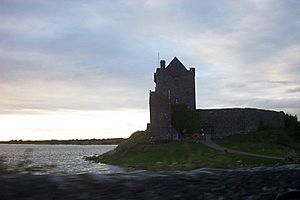Kinvara facts for kids
Quick facts for kids
Kinvara
Irish: Cinn Mhara
|
|
|---|---|
|
Village
|
|

Dunguaire Castle
|
|
| Country | Ireland |
| Province | Connacht |
| County | County Galway |
| Elevation | 10 m (30 ft) |
| Population
(2022)
|
721 |
| Dialing code | 091 |
| Irish Grid Reference | M369103 |
Kinvara or Kinvarra (Irish: Cinn Mhara, meaning head of the sea) is a lovely village by the sea in the southwest of County Galway, Ireland. It's located at the very end of Kinvara Bay, which is an inlet of Galway Bay. The village gets its name from this bay. Kinvara is part of a larger area called a civil parish known as Kinvarradoorus.
Contents
Kinvara's Location and Landscape
Kinvara village sits at the head of Kinvara Bay. This bay is a small part of the much larger Galway Bay. The village's Irish name, Cinn Mhara, means "head of the sea". Kinvara is in the northern part of an area called Kiltartan. It is also very close to The Burren in County Clare. The Burren is famous for its unique rocky landscape.
The area around Kinvara is known as the townland of Kinvarra. This townland is part of the Kinvarradoorus civil parish. To the north, it meets Galway Bay. To the east, it borders the parishes of Ballinderreen and Ardrahan. To the south, it's next to Gort and Boston. To the west, it borders Carron and New Quay.
Kinvara's Past
Early Settlements in Kinvara
People have lived in the Kinvara area for a very long time. There is proof of ancient settlements in the surrounding areas. These include old promontory forts and ring forts. These forts are found in places like Dungory West and Ballybranagan. Within Kinvara townland itself, you can also find similar old sites. There are also ruins of an old lime kiln and an 18th-century windmill.
Dunguaire Castle's Story

Dunguaire Castle is a beautiful castle from the 16th century. It is a type of castle called a towerhouse. The castle belonged to the Ó hEidhin (O'Hynes) family. It is located just east of Kinvara village. In 1574, a person named Fearadhach Ó hEidhin was listed as the owner of the castle. This list was made for an important leader, Sir Henry Sidney.
The Poulnegan Altar
The Poulnegan Altar is a special historical site near Kinvara. It is known as a Mass rock. In the local Irish language, it is called Poll na gCeann, which means "chasm of the heads". This place is important because it was used for religious services a long time ago. During difficult times, people would gather here in secret for Mass. Local stories say that some students were killed here by soldiers while attending Mass. Their heads were then thrown into a nearby chasm.
The Terry Alts Movement
In the early 1800s, a group called the Terry Alts was active in Ireland. They were a secret society of farmers who wanted better conditions. They were active in the Kinvara area. In 1831, a large group of Terry Alts gathered near Kinvara. They challenged government troops. However, the group left before the soldiers arrived. They also tried to surprise some soldiers in another area, which led to one of their members dying.
Kinvara's Changing Population
The population of Kinvara has changed a lot over time. In the 1840s, the Great Famine caused many people to leave Ireland or die. This, along with people moving away until the 1960s, made the village much smaller. Kinvara was once a busy port. It used to export corn and seaweed. But its population dropped to only a few hundred people.
However, in recent years, Kinvara has grown again. Between 1991 and 2016, the number of people living in Kinvara increased by 170%. It went from 425 people to 734 people.
Religion in Kinvara
For people who are Catholic, Kinvara is part of the Roman Catholic Diocese of Galway, Kilmacduagh and Kilfenora. The churches in Kinvara parish include Saint Colman's Church, built in 1819, and Saint Joseph's Church, built in 1877. Saint Joseph's Presbytery, which used to be a convent, was built around 1875.
Kinvara is also part of the Church of Ireland's Diocese of Limerick and Killaloe.
Fun Festivals in Kinvara
Kinvara hosts two exciting festivals every year.
- Fleadh na gCuach is an Irish traditional music festival. Its name means "cuckoo festival". It takes place at the beginning of May.
- The Cruinniú na mBád is held in mid-August. This festival means "gathering of the boats". It celebrates traditional Irish boats.
Sports in Kinvara
Kinvara is home to Kinvara GAA, which is a Gaelic Athletic Association club. This club mainly focuses on hurling, which is a fast-paced Irish sport. They also play Gaelic football at a junior level.
Famous People from Kinvara
Many notable people have connections to Kinvara:
- Ailbhe of Ceann Mhara: A religious leader from the 9th century.
- Coman of Kinvara: An early medieval saint.
- Francis Fahy: A composer and poet who wrote the famous song "Galway Bay."
- Celia Lynch: A well-known politician.
- P. J. Mara: A public affairs consultant and senator who was buried in Kinvara.
- Peter Martyn: A judge.
- Eoghan Ó hEidhin: A king of Uí Fiachrach Aidhne who died in 1340.
- John Prine: An American country folk singer-songwriter who had a home in Kinvara.
- Mathilda Twomey: The Chief Justice of the Seychelles and the first woman to hold that important job.
- Conor Whelan: A talented hurler.
- Máire Whelan: A judge and the 30th Attorney General of Ireland. She was the first woman to hold this position, serving from 2011 to 2017.




